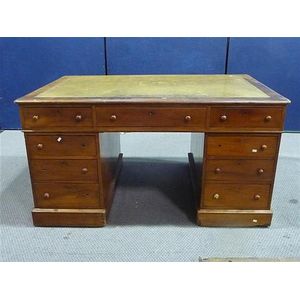Antique Cedar Twin Pedestal Desk with Leather Top
You must be a subscriber, and be logged in to view price and dealer details.
Subscribe Now to view actual auction price for this item
When you subscribe, you have the option of setting the currency in which to display prices to $Au, $US, $NZ or Stg.
- Pedestal Desk - A pedestal desk is a type of desk that consists of a large work surface supported by two pedestals or cabinets, one on either side. The pedestals are usually identical and contain drawers and cabinets for storage. The desk's design allows it to be placed in the centre of a room, as the back of the desk is usually finished with the same veneer as the front.
Pedestal desks were popular in the 18th and 19th centuries, and were usually made from high-quality wood, such as cedar, mahogany, walnut or oak, and were decorated with intricate carvings and other decorative details. They were used by businessmen, politicians, and other professionals, and were considered a symbol of status and success. - Mother-Of-Pearl - Mother-of-pearl, technical name "nacre", is the inner layer of a sea shell. The iridescent colours and strength of this material were widely used in the nineteenth century as an inlay in jewellery, furniture, (especially papier mache furniture) and musical instruments.
In the early 1900s it was used to make pearl buttons. Mother-of-pearl is a soft material that is easily cut or engraved.
Nowadays it is a by-product of the oyster, freshwater pearl mussel and abalone industries. - Blind Tooling / Blind Tooled - Blind tooling is a technique used in the decoration of leather goods such as book covers, belts, and wallets. It involves the use of specialized tools to impress designs and patterns onto the surface of the leather without the use of added colour.
The process involves the use of a variety of tools, including stamps, embossing tools, and finishing tools, which are used to create various textures and patterns on the leather surface. The tools are heated, and then pressed onto the leather, leaving an impression. The tools can be used to create designs that are simple or complex, with a variety of textures and patterns, including geometric shapes, florals, or scenes. The leather is then burnished to enhance the design and give it a smooth finish. - Tooled - Decoration of a leather surface, usually by stamping the surface with a heated punch or wheel containing foliate or geometric designs. In blind tooling the surface of the punch or wheel is in direct contact with the leather, while in gold tooling, a ribbon of gold leaf is placed between the punch or wheel and the leather, and once they have been applied, the excess gold is brushed off, leaving only the design.
This item has been included into following indexes:
-
desks, material
- cedar, large 43
- cedar, small 43
- desks, period or age
- desks, style or type - small antique pedestal 184
Visually similar items

Double pedestal mahogony desk, circa 1870 with a tooled leather insert. Height 76 cm, width 14 cm depth 95 cm

Vintage pedestal desk, with tooled gilt writing surface, 153 cm wide, 90 cm deep, 76 cm high

Federation cedar twin pedestal desk. 4 drawers per pedestal with a tooled leather top. Height 76 cm. Width 130 cm. Depth 83 cm

A Victorian double pedestal desk with nine drawers, brass handles, leather inset top, 75 x 107 x 60 cm
